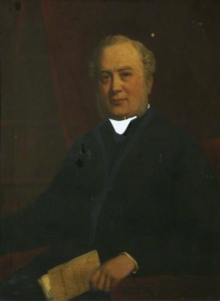Thomas Helmore
Thomas Helmore (born May 7, 1811 in Kidderminster , † July 6, 1890 in Westminster ) was a British choir director, author and composer. He is particularly known for the Advent and Christmas carols he edited .
Life
Thomas Helmore was the son of a congregational preacher. He grew up in Stratford-upon-Avon , where his father had founded a school, attended Mill Hill School and studied from 1837 at Magdalen College , Oxford . After his graduation in 1840 he was appointed priest of the Church of England ordained . His first position was at St Michael on Greenhill Church in Lichfield ; at the same time he was vicar at Lichfield Cathedral .
In 1842 he was appointed cantor and assistant director at St. Mark's College, Chelsea (now part of the University of St Mark & St John, Plymouth ). Here he worked until 1877.
From 1846 he was also choirmaster (Master of the Children) of the Chapel Royal in St James's Palace . Arthur Sullivan was one of his choristers.
His work coincided with the rediscovery of a cappella singing and Gregorian chant ( Plainsong ) in the Church of England. Helmore contributed greatly through his works such as The Psalter Noted (1849) and Primer of Plainsong (1877).
Helmore often worked closely with pastor, poet and translator John Mason Neale . In 1853 the British diplomat George John Robert Gordon from Stockholm brought a copy of the first edition of the Piae cantiones to Great Britain and made it available to Neale. Neale turned to Helmore about the melodies written in white mensural notation . Together they used texts and melodies from the Piae Cantiones for two publications. First published in 1853 twelve Carols for Christmas-tide by Novello in London. The melodies were all from Piae Cantiones ; the texts were either more or less free transcriptions. For Good King Wenceslas , Helmore took the melody of the spring song Tempus adest floridum . A collection of twelve Carols for Easter-tide followed the following year . The Christmas carols in particular quickly gained great popularity and found their way into many English-language hymn books. For the Christmas carol Of the Father's love begotten , a translation of Neales to Venantius Fortunatus , Helmore used the melody of Divinum mysterium , a Eucharistic hymn.
Helmore gave the copy before his death in 1890 on to the Anglican priest and hymnologist George Ratcliffe Woodward (1848-1934). Woodward published a new edition of the Piae Cantiones in 1910 for the Plainsong & Medieval Music Society .
In another collection, The Hymnal Noted from 1851, published jointly with Neale, the most common melody of O Come, O Come, Emmanuel in English-speaking countries can be found for the first time .
Since 1844 he was married to Kate, b. Pridham.
He was buried in Brompton Cemetery .
Works
- A Manual of Plain Song; containing: - A Brief Directory of the Plain Song used in the Morning and Evening Prayer, Litany, and Holy Communion; together with The Canticles and Psalter Noted. 1850
- Accompanying Harmonies to the Hymnal Noted. 1852
- Accompanying Harmonies To The Brief Directory Of The Plain Song: Used In The Morning And Evening Prayer, Litany, And Holy Communion. 1853
- Carols for Christmas-Tide. , 1853 (with John Mason Neale )
- Carols for Easter-Tide. 1854 (with John Mason Neale )
- The Hymnal Noted. 1854
- The Ancient Plain-Song of the Church: Adapted to the American Book of Common Prayer. 1855
- The Psalter Noted: Carefully Compared and Made to Agree with the Psalter of the Standard Prayer. (with Edward M. Pecke) 1856
- Christ Was Born on Christmas Day: A Carol (with JM Neale), illustrated edition 1864
- Primer of Plainsong. 1877
- English translation by François-Joseph Fétis : Treatise on Choir and Chorus Singing. 1885
literature
- Frederick Helmore: Memoir of the Rev. Thomas Helmore. 1891, archive.org
- Bernarr Rainbow: Helmore, Thomas. In: Grove Music Online (English; subscription required).
Web links
Individual evidence
- ↑ Thomas Helmore at Cyberhymnal
- ↑ a b Bernarr Rainbow: Helmore, Thomas. In: Grove Music Online (English; subscription required).
- ↑ Carols for Christmas-tide . ( Wikisource )
- ↑ The words, for the most part, are only free imitations: sometimes of the carols in hand, sometimes of others. Foreword, quoted from Carols for Christmastide at hymnsandcarolsofchristmas.com
- ↑ George Ratcliffe Woodward: Piae Cantiones: A Collection of Church & School Song, chiefly Ancient Swedish, originally published in AD 1582 by Theodoric Petri of Hyland. Chiswick Press for the Plainsong & Medieval Music Society, London 1910
| personal data | |
|---|---|
| SURNAME | Helmore, Thomas |
| BRIEF DESCRIPTION | British choir director, author and composer |
| DATE OF BIRTH | May 7, 1811 |
| PLACE OF BIRTH | Kidderminster |
| DATE OF DEATH | July 6, 1890 |
| Place of death | Westminster |


